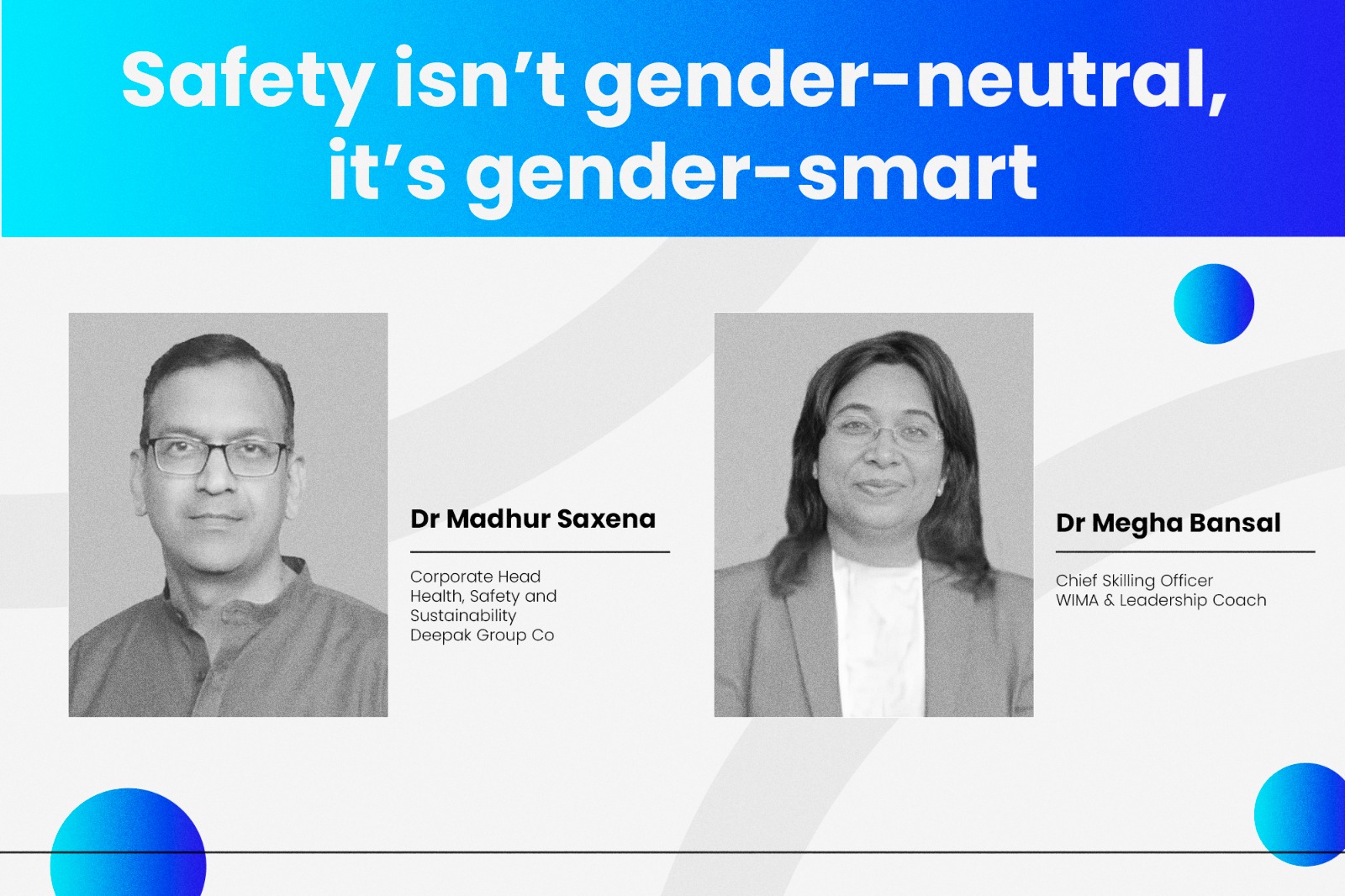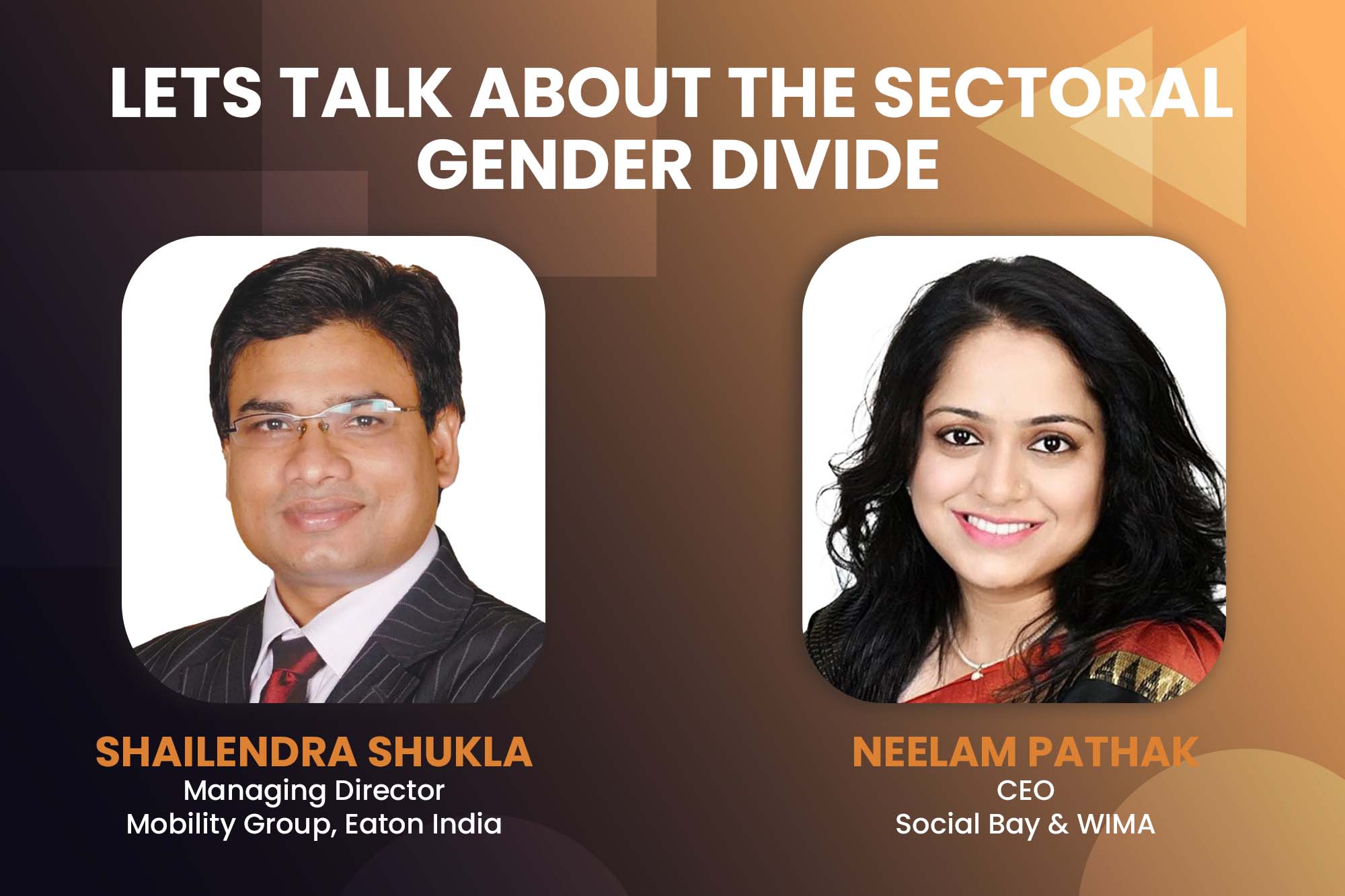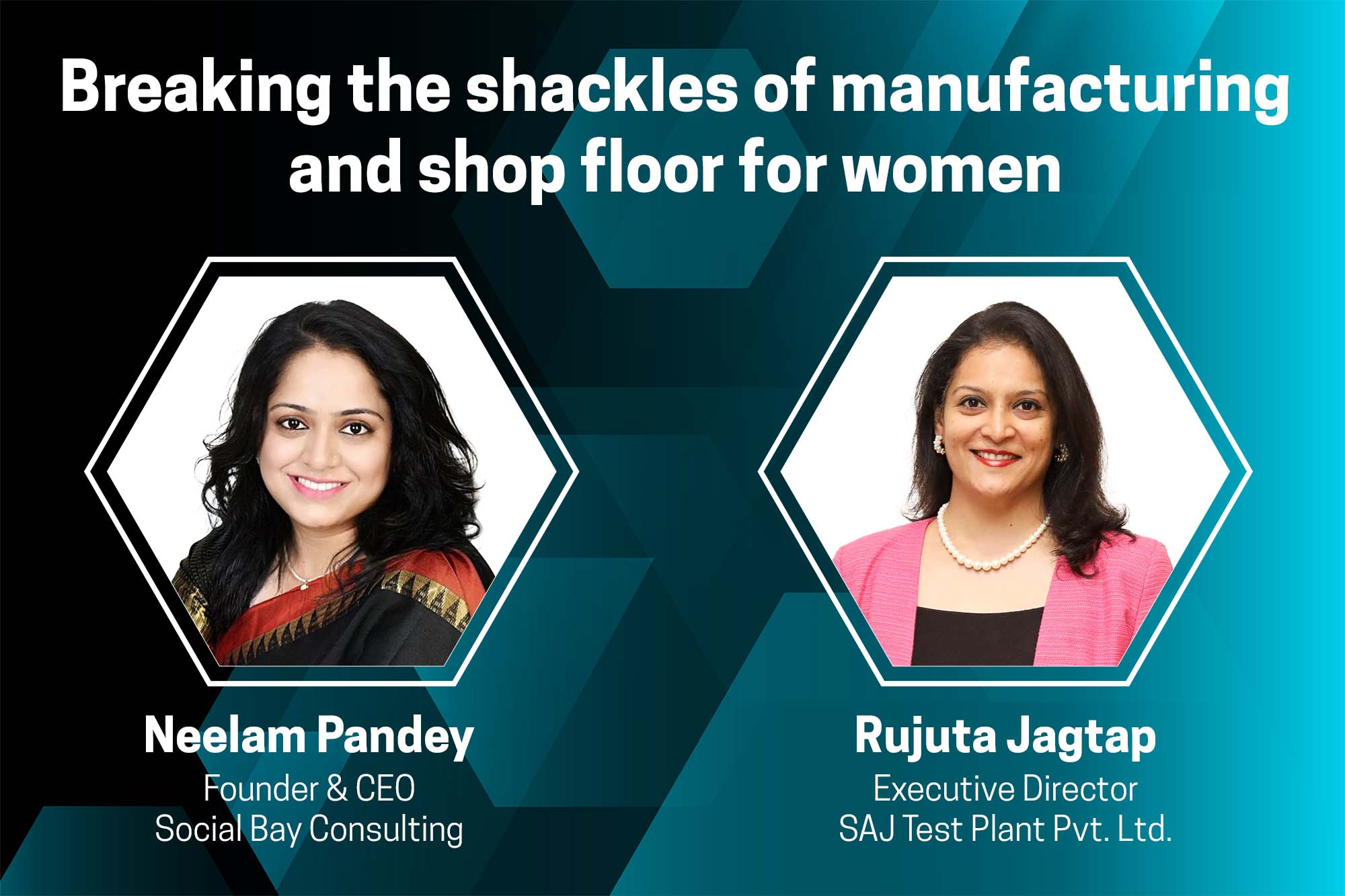Safety isn’t gender-neutral, it’s gender-smart
By Staff Report June 10, 2025 10:50 am IST
“Building a strong environment is essential for any organisation and must include women and diverse employees. McKinsey & Company found that gender-diverse leadership teams are 21% more likely to achieve higher profitability. At the same time, the Institute for Women’s Policy Research reports that women in male-dominated industries face 35% more harassment.”
Dr Madhur Saxena, Corporate Head – Health, Safety and Sustainability at Deepak Group Co, in conversation with Dr Megha Bansal, Chief Skilling Officer WIMA & Leadership Coach, shares how Behaviour-Based Safety (BBS) initiatives are addressing the specific needs of women and diverse employees. A holistic approach that includes leadership commitment, ongoing training, and open communication is crucial.
In your experience, what are the most critical steps in building a strong safety culture in manufacturing setups, and how can organisations ensure this culture is inclusive for women and diverse employees?
Building a strong safety culture in manufacturing setups requires a multi-faceted approach. We at Deepak Group, strongly believe that each of us is a Safety Leader and is empowered to pro-actively own and drive a safety-first culture. It is this mindset and confidence of the workforce that is what makes an organisation successfully build a robust safety culture. In my experience as an expert across the industry, over the years, I would say that at the core are five critical steps that organisations should take:
1. Leadership commitment and accountability
A robust safety culture starts with leadership. In Organisations where the senior leaders demonstrate unwavering commitment to safety, both in their actions and words, safety organically becomes a part of the shop floor mindset and culture. When leadership is actively involved and holds itself accountable for safety outcomes, it sets the tone for the rest of the organisation and leads to every employee making safety a priority not only for themselves but also for the organisation.
2. Training and Re-Training
Manufacturing environments are fast paced, so training should be regularly updated to cover new technologies, processes, and risks. Our experience has shown that training programs will fail to deliver results on the shop floor if they are not aligned with the actual on-ground training needs of the fast-evolving workforce. Smart and progressive organisations regularly invest in robust training needs identification program that takes input from the shop floor, and various data points like unsafe acts, unsafe conditions, near misses, and past incidents. The impact of this consistent and rigorous focus on training has helped many companies reduce accidents by up to 60%.
3. Open Communication
“Good News is No News, No News is Bad News, and Bad News is Good News” in the world of safety improvement. If an employee is coming up to report any bad news like an unsafe act, or a safety violation then it is a good sign for the company. As this means that the organisation has been able to build a culture of safety, trust and confidence in their workforce to have open communication, be it employees, or even contractual workforce. It is imperative that people in a manufacturing ecosystem are comfortable to share and report information and incidents to bring improvement in leading & lagging indicators of safety
4. Employee Participation
The key to driving a Safety-First organisation is to have engaged and active Employee participation, with no discrimination or biases, where each one believes that they are owners of their own safety. “Safety is not something which can be added to the Job, it’s the way to do the Job”. So, we have to understand that only when the teams on-ground are involved in shaping the safety culture, they will be able to own safety outcomes, and the organisation will be able to see the safety culture implemented.
5. Reward and Progressive Disciplinary Matrix
Rewards play a crucial role in motivating employees to achieve their tasks efficiently. However, it’s important to strike a balance, as excessive rewards can undermine the safety culture. When employees become overly dependent on rewards, they may struggle to perform tasks without them. Therefore, a well-structured reward system should be complemented by a progressive disciplinary matrix to address wilful violations, ensuring a safe and productive work environment.
Safety Culture of Diversity, Equity & Inclusion
While building a strong safety culture, it is equally important to ensure that the safety culture is inclusive, particularly for women and diverse employees. While the industry has been working consistently on improving and strengthening measures for women safety, it is still a concern across India Inc. A few years back, The Institute for Women’s Policy Research found that women in male-dominated industries, such as manufacturing, are 35% more likely to experience harassment. The industry has come a long way since then with many focussed and committed measure to adopting Zero Tolerance for Harassment and Discrimination by addressing gender-specific needs, promoting diverse leadership in safety roles, and ensuring inclusive safety practices.
It is the need of the hour for Organizations to ensure that they create an environment where safety is a shared responsibility and everyone feels protected and valued. This not only improves safety outcomes but also leads to higher employee satisfaction and overall organizational success.
The aim is to make So we need to take care at both fronts.
While developing an inclusive safety culture we also discuss about “Care”. We do BBS (Behaviour Based Safety) because we care and the care no one can understand better than Women. While addressing our program we need to take care of their specific needs of women and Diverse employees at shop floor. Some time with Specific PPE’s, Specific Training and specially Zero-Tolerance Policy for Harassment and Discrimination.
Building a strong safety culture in manufacturing requires a holistic approach, where leadership commitment, ongoing training, open communication, and employee involvement are all crucial components. At the same time, it’s vital that this culture is inclusive for women and diverse employees. By addressing gender-specific needs, promoting diverse leadership in safety roles, and ensuring inclusive safety practices, organizations can create an environment where safety is a shared responsibility, and everyone feels protected and valued. This not only improves safety outcomes but also leads to higher employee satisfaction and overall organizational success.
What specific safety challenges may women face on the shop floor, and how can organisations redesign workplace safety protocols to address gender-specific concerns?
The Manufacturing sector over the last few decades has seen tremendous transformation with state-of-the-art plants, technologies and infrastructure combined with employee-centric policies and robust ecosystems to support diversity, equity and inclusion. This is also visible in the safety space, and more so with much care when it comes to women in manufacturing.
Women in manufacturing environment often face unique safety challenges, if safety protocols are not designed with gender-specific needs in mind. Addressing these challenges is crucial for creating an equitable and safe workplace for all employees.
- Women centric PPEs:
Industry reports show that women at workplace are 2.5 times more likely to experience discomfort or safety hazards when using ill-fitting PPE. Standard PPE, such as safety gloves, helmets, eye protection, and body suits, is often designed primarily for male workers, leading to discomfort or ineffective protection for women. This can result in increased risk of injury or inefficiencies in the job.
Ergonomically designed PPE specifically for women that fits to women’s body types are now being designed and customised by companies along with proper protection and comfort to solve the problem. Similarly, safety gloves, Helmets and protective clothing with better dexterity and work boots designed for women’s foot shapes are being made to reduce discomfort and improve overall safety.
2. Shopfloor Safety for women
Women in manufacturing may sometimes experience higher rates of musculoskeletal disorders (MSDs) compared to men, often due to handling heavy materials and working in physically demanding environments. Women generally have lower muscle mass and different biomechanical needs compared to men, which can increase the risk of strain or injury from repetitive tasks or lifting.
To mitigate this, Job rotation at a frequent interval has minimized the risk of repetitive motion injuries.
- Additionally, using of ergonomic tools, adjustable workstations, and robotic lifting aids designed to reduce strain on the body reduce the risk drastically.
- Apart from this, many companies consider creating jobs or tasks that accommodate various strength levels without compromising safety.
- Tailoring of training program to women’s specific needs (i.e., focusing on joint mobility, strength endurance, and posture) are also help prevent musculoskeletal injuries.
- Modify Work Tasks for Pregnant Women Workforce to ensure no Tasks that involve lifting heavy loads, exposure to harmful chemicals, or excessive standing is avoided.
- Establish clear policies on maternity leave, flexible work hours, and accommodations for pregnant employees. Having a system in place to manage potential risks will make the workplace safer for all employees.
- Ensure that workspaces, restrooms, and locker rooms are designed to be inclusive for all employees, regardless of gender. This includes creating adequate spaces for women to store personal items safely, providing more accessible bathrooms, and ensuring that machinery and tools can be operated by individuals of varying sizes.
3. Safe Working Environment for Women
Women in male-dominated manufacturing environments may sometime experience harassment, discrimination, or even physical threats, which can undermine their physical and psychological safety. This often discourages women from speaking up about safety concerns, potentially leading to underreporting of hazards or unsafe practices.
Every company should have a Zero-Tolerance Policy and strict enforcement, regular training on harassment prevention and Clear, accessible and confidential channels reporting mechanism to ensure a safe working environment for all women and diverse gender employees.
All employees irrespective of Race, Gender, Cast and Religion, should feel safe from any inappropriate and unwelcome behaviour.
We should Foster a safety culture where all employees’ concerns are valued, regardless of gender. Train managers and supervisors to actively listen and address safety concerns raised by women in the workplace. Regular Feedback and anonymous Surveys is the most important way to gauge employees’ concerns.By addressing these gender-specific safety challenges, organizations can create a more inclusive and safer workplace for all employees, particularly women. Redesigning PPE, modifying work tasks, addressing harassment, and providing supportive policies for pregnant workers are key steps to ensuring safety and reducing risks. It is important to consider the diverse needs of the workforce in the development of safety protocols and workplace design to promote an environment where everyone can thrive.
How can the principles of process safety be adapted to ensure safer working environments that attract and retain more women in technical and operational roles?
A study by McKinsey & Company highlights that companies with gender-diverse leadership teams are 21% more likely to outperform on profitability.
A critical component of process safety is ensuring that workers feel secure in their environment, both physically and emotionally.
Regular training on harassment and inclusion addresses safety protocols and prevention and fosters a respectful workplace. Empower employees to report inappropriate behaviour and ensure no retribution risks.
Diversity and inclusion in safety leadership positions, especially in safety-related roles, can reinforce the importance of inclusion in safety culture. Women in leadership roles can help build trust and improve employee safety outcomes.
Mentorship and career development in process safety should focus on immediate safety measures and foster career growth and development opportunities for women in technical and operational roles.
Women, particularly those in technical and operational roles, may require more flexibility to balance work and personal life. Offering flexible work policies that support work-life balance can help attract and retain women in safety-critical roles, reducing burnout and increasing job satisfaction.
To attract women to technical roles, it is important to create an inclusive safety training environment where everyone feels supported, regardless of gender.
Ensure that safety training materials and programs are gender-neutral and represent the diverse workforce.
Representation matters in process safety roles. Organisations should actively promote female role models in safety leadership positions to attract and retain more women.
How does behaviour-based safety contribute to employee well-being and workplace trust? Are any behavioural insights specific to improving safety engagement among underrepresented groups like women?
Behaviour-based safety (BBS) is a proactive strategy that focuses on reinforcing safe behaviours in the workplace. An inclusive BBS approach is crucial for engaging underrepresented groups, particularly women, who may face unique challenges on the shop floor.
BBS encourages employees to take ownership of their safety and that of their colleagues, fostering a greater sense of control and responsibility. Continuous feedback on safety practices fosters trust and ensures that concerns are addressed.
Positive reinforcement: BBS fosters a supportive environment that values employees, thereby boosting morale and job satisfaction. This is particularly important for women in male-dominated industries, who may hesitate to report safety concerns. Tailored strategies, like regular check-ins and anonymous reporting, can help ensure their voices are heard.
Focusing on “CARE”: BBS programs should include women in leadership roles and involve them in developing safety initiatives. Creating a peer network can also support and empower women, promoting collective responsibility for safety. Addressing unique concerns, such as ergonomics and the use of appropriate personal protective equipment (PPE), and soliciting feedback from women will enhance the effectiveness of safety programs.
How do you view the link between safety, sustainability, and social inclusion in the context of responsible manufacturing? Can safety culture contribute to broader ESG goals?
The link between safety, sustainability, and social inclusion is integral to responsible manufacturing, where companies strive to have a positive impact on the environment, society, and the economy. These three pillars—safety, sustainability, and social inclusion—are deeply interconnected, and the safety culture can advance an organisation’s broader Environmental, Social, and Governance (ESG) goals.
Safety is the cornerstone of any responsible manufacturing operation. Without a strong safety culture, preventable accidents, injuries, and inefficiencies may undermine efforts toward sustainability and social inclusion. A well-established safety culture directly impacts worker well-being, operational efficiency, and the company’s reputation. Effective safety practices often overlap with environmental considerations. For example, safe handling of hazardous materials, preventing spills or accidents and ensuring proper waste management practices are essential to avoid environmental contamination. A strong safety culture helps mitigate risks that could impact the environment, contributing to more sustainable operational practices.
Sustainability in manufacturing means reducing environmental impact while fostering an operational culture that benefits employees, communities, and the planet.
Safety is essential for achieving sustainability goals. By incorporating environmental safety protocols into operations, manufacturing companies can reduce their ecological footprint and enhance sustainability. Well-maintained machinery and well-trained workers lead to less waste, lower energy consumption, and greater resource efficiency.
A safety-focused workplace improves employee health, productivity, and satisfaction and contributes to social well-being, particularly for marginalised groups. Creating safe environments demonstrates social responsibility.
A strong safety culture promotes social inclusion by fostering trust among diverse employees and ensuring everyone feels valued. It also supports Environmental, Social, and Governance (ESG) goals, which are increasingly important to stakeholders. Safety minimizes environmental risks and ensures sustainable practices are executed safely while addressing issues like workplace harassment and discrimination.
Moreover, safety culture reflects a company’s commitment to transparency and ethical practices, leading to better governance and trust with stakeholders, including regulators and investors.
What role does leadership play in embedding a safety-first mindset while promoting diversity, equity, and inclusion (DEI) in manufacturing organisations?
Leadership in manufacturing organisations must prioritise a safety-first mindset while promoting Diversity, Equity, and Inclusion (DEI). Effective leaders set the tone for cultural change, ensuring that safety and DEI are integral to the organisation. They must cultivate a safety-first approach, personally committing to safety protocols and clearly communicating expectations to the entire workforce.
Leaders should advocate for Diversity, Equity, and Inclusion (DEI) by establishing a clear vision and promoting diversity in leadership and decision-making processes.
Leaders can create a cohesive culture where safety and DEI coexist by emphasising safety and inclusive behaviours, such as encouraging diverse contributions to safety discussions. Comprehensive safety policies should address physical, mental, and emotional well-being, ensuring inclusivity for all employees.
Leaders should foster open communication by holding regular listening sessions, empowering employees to discuss safety and diversity, equity, and inclusion (DEI) concerns. Tracking safety performance and setting measurable goals for improvement are essential, as is holding the organisation accountable for its DEI objectives.
Safety and DEI must be addressed holistically; physical safety also includes emotional and social well-being, particularly for women and minorities. Leaders can integrate sustainability principles into their safety and diversity, equity, and inclusion (DEI) efforts, aiming for long-term improvements in workplace conditions and representation.
Cookie Consent
We use cookies to personalize your experience. By continuing to visit this website you agree to our Terms & Conditions, Privacy Policy and Cookie Policy.

















